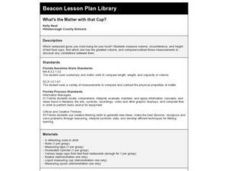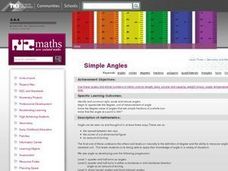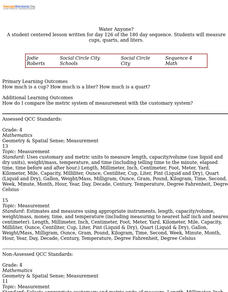Curated OER
Surface Area with Polydrons
Students explore measurements by analyzing geometric shapes. In this surface area lesson, students identify the terms volume, weight, perimeter and area in order to find the requested measurements of specific polygons. Students utilize...
Curated OER
The Time of Man
Young scholars demonstrate visually Mankind's relative place on the earth's timeline. They familiarize themselves with the use of the metric system in measuring and producting a timeline.
Curated OER
Genetic Variations in Hand Span Size
Students study genes. For this biology lesson plan, students measure their handspan size to determine if one pair or many pairs of genes control that trait.
Curated OER
Leaping Lemurs! How far can you jump?
Students watch a segment of the PBS video which show the lemurs' ability to jump. In pairs, students collect measurement data involving each other's length of a standard step, a standing broad jump, and a long jump. They record their...
Curated OER
What's the Matter with that Cup?
Fourth graders measure volume, circumference, and height of fast food cups, find which one has the greatest volume, and compare/contrast those measurements to discover any correlations between them.
Curated OER
Simple Angles
Third graders identify and construct right, acute and obtuse angles and begin to appreciate the degree and unit of measurement of angle. They know the degree value of angles that are simple fractions of a whole turn know that the angle...
Curated OER
Shaquille O'Neal Hand/Foot Span
Eighth graders measure foot length and hand span in this experiment to determine the ratio. They apply the ratio to determine Shaquille O'Neal's hand span if given his shoe size.
Curated OER
Circles Minilab
Students learn how to measure the diameter and circumference of a circle. In this circle instructional activity, students organize their data to create a graph. Students utilize their graph to make an inference about the slope of pi.
Curated OER
Puzzling Perimeters
Third graders use estimation, fractions and decimals to determine the perimeter of objects in the classroom. They are given a worksheet with a list of the items on it. The worksheet has columns beside each of the items for estimation and...
Curated OER
Hop To It!
Students explore the aspects of a frog's anatomy that allow it to be such a good jumper and jump and record the length of each jump to determine which style of jumping allows them to jump the farthest.
Curated OER
FOOTSTEPS IN TIME
Students measure and correlate their foot lengths and body heights, then use this data to estimate height of Laetoli hominids. They use metric measurement and graphing to determine these heights.
Curated OER
Whose Skeleton is in Your Closet?
Students analyze and measure parts of a model skeleton to determine sex, race, height and age. They produce a lab report from their inquiries.
Curated OER
Building a Scale Model
Third graders create a model of the solar system. In this solar system lesson, 3rd graders create a scale model of the solar system. Working in pairs students solve mathematical problems to correctly measure the distance each planet is...
Curated OER
Cool Times with Heat
Students work with thermometers to complete problems about temperature. They investigate cooling patterns, how location affects temperature, and what happens when water having different temperature is mixed. They measure temperature in...
Curated OER
Garden Variety Geometry
Learners prepare to take the GED by reviewing basic math concepts. In this geometry activity, students review vocabularies such as formula, perimeter, circumference and other important geometric terms. They convert between the English...
Curated OER
How do You Stack Up? Revisited
Students estimate the thickness of coins. In this stack up lesson, students stack pennies, nickels, dimes and quarters. They calculate and record the thickness of each coin. Students stack coins and estimate the height of the stack.
Curated OER
Classroom Meteorologists: An Experiential Approach to Learning about Seasons and Weather
Students examine several concepts about weather in the seven lessons of this unit. This year long activity helps students to gather data seasonally about wind, clouds, precipitation, and temperature. Earth's three climate zones are...
Curated OER
Oranges and Stopwatches
Students begin to recognize that objects have many measurable attributes. They examine how to identify and accurately measure attributes of common objects. Also Students report their measurement findings.
Pennsylvania Department of Education
The Weight of Things
Learners explore weight. In this math lesson, students predict which item weighs more and discuss how they arrived at their decision. Learners weigh several items to determine which weighs more.
Curated OER
Ratios
Students explore the concept of ratios. In this ratios lesson, students use matchbox cars and models of spaceships to explore ratios. Students determine scale for the above mentioned objects in this lecture style lesson.
Curated OER
Volume of a Cube without a Picture
In this geometry worksheet, students draw and calculate the volume of a cube from the given side length measured in metric or customary. There are 8 questions with provided workspace.
Curated OER
How far is a km?
Students explore the size of a kilometer and the time it takes to cover this distance. They develop a concept of a km. They measure a distance of 1 km and the time taken to cover it.
Curated OER
Focus: Word Processing
Sixth graders explore the basic units and prefixes of the metric system. They select a fairy tale or nursery rhyme to revise and rewrite with blanks where the metric system terminology can be inserted. Students, following given...
Other popular searches
- Measuring Length Metric
- Measure Metric Lengths
- Measuring Metric Lengths
- Metric Length Measurements
- Measureing Metric Length























